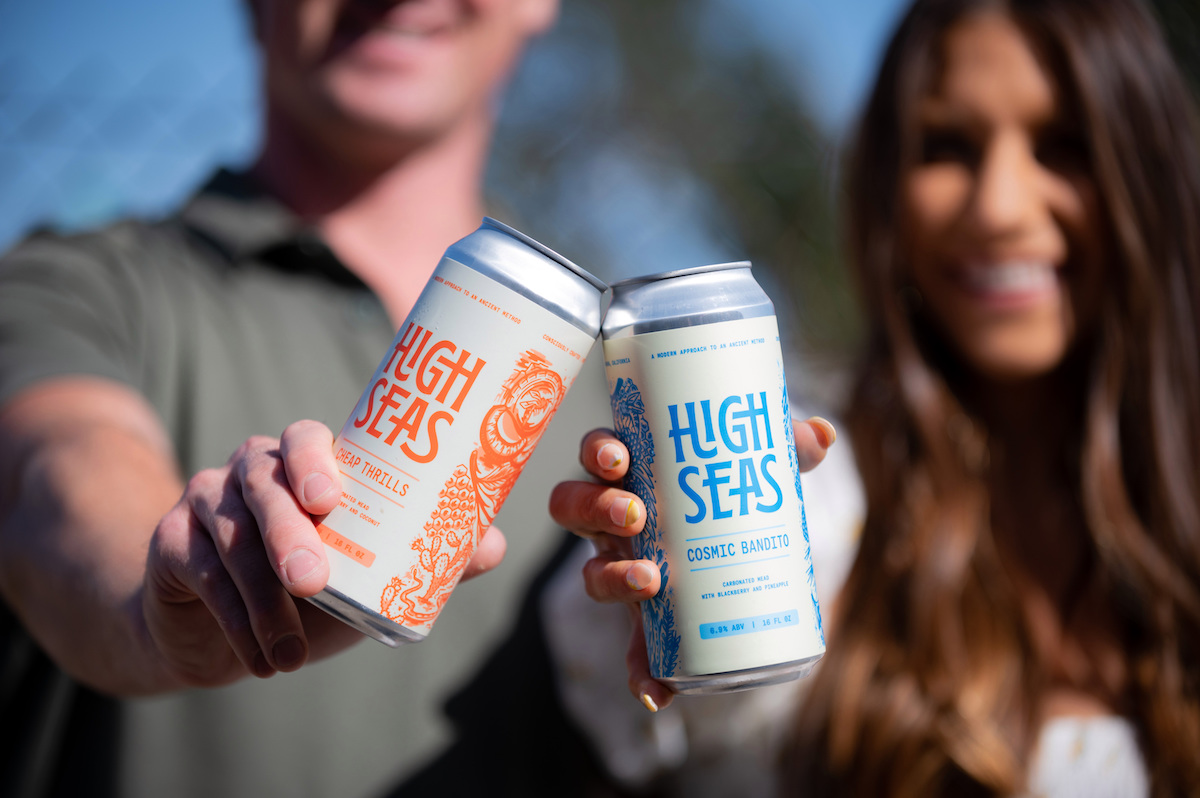High Seas Meadery Spins Honey into Carbonated Gold
Santa Barbara’s Austin Corrigan Crafts Fruit-Spiked Mead Near Old Town Goleta

Santa Barbara’s Austin Corrigan Crafts Fruit-Spiked Mead Near Old Town Goleta


Head-on collisions have a way of putting life into focus. When Austin Corrigan’s 2018 car crash at the intersection of State and Alamar streets totally shattered the Santa Barbara native’s right leg, his journey through a full year of recovery wound up rerouting his career from itinerant chef to maker of mead, the fermented honey wine that many believe to be humankind’s first alcoholic beverage. Today, he’s selling four, all-organic flavors of his carbonated High Seas Mead to a growing number of stores and restaurants around Santa Barbara, recently launched a mead club, and is already eyeing expansion.
“I never thought I would be doing this,” said the 27-year-old, who brewed his first commercial batch last October in an Old Town Goleta facility. “I was so all over the place just a few years ago. It’s so fun watching this thing blossom and grow. Driving on the Mesa and seeing people at Corner Tap with my can in their hand? It makes me smile from ear to ear. It’s so cool.”
Admittedly a troublemaker in his youth, Corrigan graduated from Santa Barbara High in 2011, and by 21 was attending the Culinary Institute of America in Napa, where he worked for restaurants, caterers, and wineries. A six-month gig in Jackson Hole, Wyoming, led to a full-time job, which he’d just started when he returned to Santa Barbara to see his parents for Thanksgiving. He was on his way back from Whole Foods in a small car when someone driving a big truck tried to take that tricky left on Alamar but instead smashed into Corrigan. “You can imagine who won that fight,” he said.
His right patella and femur were dusted. “At the time it was so terrible,” he recalled. “I was not in a good place. Being a very athletic individual, it just wiped all that off the table for a while.”
While Corrigan regained strength, a friend and trainer of his suggested they make some mead, which, at its most simple iteration, is honey fermented with yeast in water. The drink’s human history stretches back to East Africa, where early humans likely found rain-soaked hives full of a sweet, slightly funky liquid that made them feel funny.

Corrigan only knew mead as a sweet, higher-alcohol beverage, but his friend said it could be made dry and lighter, so they gave it a try in a makeshift garage lab. This first batch was “awful,” but the second wasn’t so bad. They considered starting a business together, but parted ways due to differing visions.
Corrigan kept trying new recipes for more than a year. “I saw the hard kombucha market and hard cider market really exploding,” he explained of the potential for mead, but he needed a fresh angle. “How can I make mead modern? How can I make it approachable for younger individuals, people who are seeking these alternative, more health-minded alcohols?”
He found the Goleta warehouse in August — right around the time he was also working as a firefighter for the Los Padres National Forest — and used money that he got from his car-crash settlement “to make this dream and this vision happen.” Corrigan named the new brand High Seas to acknowledge his “love affair” with the ocean, which was strained due to his injuries. “I’ve missed being out there so much,” he said. “It was fitting.”
A few years ago, I wrote an article about American mead for Wine Enthusiast, tasting 24 meads from 10 different producers across the country, which maybe made me, for a very brief period, the country’s leading expert on mead. I’m happy to report that High Seas is better than every single one of those that I tasted back then. All four flavors — Cosmic Bandito (pineapple/blackberry), Cheap Thrills (coconut/raspberry), Mystic Vibrations (watermelon/lemon), and Meadacolada (pineapple/coconut) — are refreshingly light with just enough fruit flavor to keep them interesting.
The honey impact, which imparts a generic sameness to many other meads on the market, is happily quite muted. Finding regionally harvested honey to be prohibitively expensive, Corrigan sources Brazilian wildflower honey from a family-owned company called Bee Seasonal Honey. For fruit, he buys some from Whole Foods and Sprouts, but also takes the culled berries from the Driscoll’s that would otherwise go to waste. For yeast, he’s opting for a gluten-free cider yeast, which is quicker and crisper than the champagne or white wine yeasts typically used in mead.
He’s looking into buying a facility down near the Funk Zone, where he could increase production by 30 barrels. “That would allow us to grow outside of this 50-mile range that we are focused on right now,” explained Corrigan, who is also going through the organic certification process to get into the farmers’ market. “I’m committed to this, and I’m gonna keep going for as long and as big as I can.”
He’s confident that the mead market will grow in the same sharp trajectory that cider and kombucha recently experienced. “I believe it’s gonna be the next big product,” said Corrigan. “It’s ultimately the world’s oldest fermented beverage. Let’s bring it back. Let’s keep it around. Let’s not let it get lost as we evolve. We can’t lose that.”
See highseasmead.com or follow on Instagram @highseasmead.
Support the Santa Barbara Independent through a long-term or a single contribution.
Please note this login is to submit events or press releases. Use this page here to login for your Independent subscription
Not a member? Sign up here.
You must be logged in to post a comment.